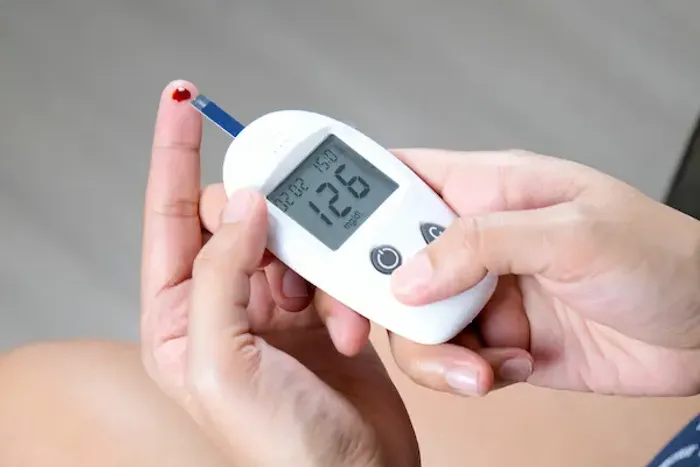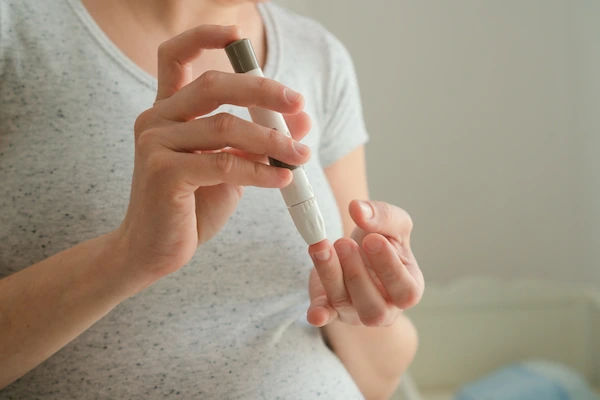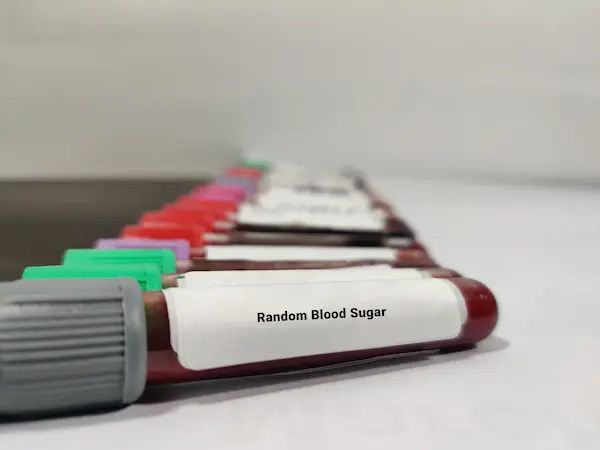Guide to Ppbs Test Normal Range
Know about the PPBS, what it is, the difference between PPBS and FBS, how to maintain a healthy PPBS and the interpretation of test results.

Written by Dr. Dhankecha Mayank Dineshbhai
Reviewed by Dr. Rohinipriyanka Pondugula MBBS
Last updated on 12th Sep, 2025

Introduction
Have you ever wondered what happens to your blood sugar after a meal? The Postprandial Plasma Blood Sugar (PPBS) test is a simple yet powerful diagnostic tool that answers exactly that. Measuring your glucose levels two hours after eating, the PPBS test provides a crucial snapshot of your body's ability to manage sugar. Understanding your PPBS test normal range is a fundamental step in assessing your metabolic health, identifying potential risks for diabetes, and effectively managing the condition if you already have it. This comprehensive guide will demystify the PPBS test, explain what your results mean, and offer practical advice on how to keep your post-meal sugar levels within a healthy range. Whether you're monitoring an existing condition or just being proactive about your health, this article will equip you with the knowledge you need.
What is a PPBS Test? Understanding Postprandial Blood Sugar
The term "postprandial" simply means "after a meal." Therefore, the Postprandial Plasma Blood Sugar (PPBS) test is a blood test that measures the concentration of glucose in your bloodstream exactly two hours after you start eating a meal. This timing is critical because it captures the peak level your blood sugar typically reaches after digestion. Unlike the Fasting Blood Sugar (FBS) test, which measures your baseline sugar level after an overnight fast, the PPBS test evaluates how efficiently your body responds to a glucose load. When you consume carbohydrates, they are broken down into glucose, causing blood sugar levels to rise. In response, a healthy pancreas releases insulin, a hormone that helps cells absorb this glucose for energy. A PPBS test checks how well this entire system is functioning. If your body isn't producing enough insulin or is resistant to its effects, glucose will remain elevated in the blood, leading to a high PPBS reading. This makes the test a cornerstone in the diagnosis of diabetes and a key metric for long-term glycemic control.
Consult a Diabetologist for Personalised Advice
PPBS Test Normal Range: Breaking Down the Numbers
Interpreting your PPBS test result hinges on comparing it to established standard values. These ranges help categorise your glucose metabolism as normal, indicative of prediabetes, or suggestive of diabetes.
Normal PPBS Range for Adults Without Diabetes
For a healthy individual without diabetes, the body efficiently clears excess glucose from the bloodstream. The widely accepted normal ppb level after 2 hours is below 140 mg/dL (7.8 mmol/L). A result within this range indicates that your insulin response is working correctly, effectively managing the post-meal spike in blood sugar.
PPBS Levels in Prediabetes: The Grey Area
A PPBS reading that falls between 140 mg/dL and 199 mg/dL (7.8 to 11 mmol/L) is considered abnormal and is classified as prediabetes, also known as impaired glucose tolerance. This is a critical warning sign. It means your blood sugar is higher than normal but not high enough yet for a type 2 diabetes diagnosis. Importantly, prediabetes is a reversible state. With positive changes in diet and lifestyle, you can often return your blood sugar levels to the normal range and prevent or delay the onset of diabetes.
Diabetic PPBS Target Range: Goals for Management
If your PPBS test result is 200 mg/dL (11.1 mmol/L) or higher on two separate occasions, it is a primary criterion for diagnosing diabetes. For individuals already living with diabetes, the American Diabetes Association (ADA) generally recommends a postprandial glucose target of less than 180 mg/dL (10 mmol/L). Achieving this target helps reduce the risk of diabetes-related complications.
PPBS in Pregnancy: Gestational Diabetes Monitoring
Pregnancy hormones can cause insulin resistance. To screen for gestational diabetes, a similar postprandial glucose normal value is used. Typically, a PPBS level under 120 mg/dL one hour after a meal or under 140 mg/dL two hours after a meal is targeted for pregnant women. Managing blood sugar is crucial for the health of both the mother and the baby.
Understanding Your PPBS Test Results: High, Low, and Normal
What Causes High PPBS Levels? (Hyperglycemia)
A high PPBS level, known as hyperglycemia, primarily points to the body's inability to use insulin effectively. Common causes include:
- Diabetes and Prediabetes: The most common cause, due to insulin deficiency or resistance.
- Dietary Choices: Consuming a meal very high in refined carbohydrates and sugars.
- Inactivity: Lack of physical activity after eating.
- Illness or Stress: Physical stress from an infection or emotional stress can elevate blood sugar.
- Certain Medications: Such as steroids or diuretics.
- Symptoms of high PPBS can include increased thirst, frequent urination, blurred vision, and fatigue.
What Causes Low PPBS Levels? (Hypoglycemia)
While less common from a standard meal test, a low PPBS level (hypoglycemia) can occur, especially in people on
diabetes medication. Causes include:
- Excessive Diabetes Medication: Taking too much insulin or oral hypoglycemic agents.
- Delayed or Inadequate Meal: Not eating enough carbohydrates for the medication dose taken.
- Strenuous Exercise: Unusually intense physical activity after taking medication.
- Symptoms include shaking, sweating, dizziness, confusion, and palpitations. If your condition does not improve after trying these methods, like consuming a quick-acting sugar source, book a physical visit to a doctor with Apollo24|7 to adjust your medication plan.
PPBS vs. FBS vs. HbA1c: How These Diabetes Tests Differ
It's easy to confuse common blood sugar tests. Here’s how they differ:
- PPBS (Postprandial Blood Sugar): A short-term snapshot, measuring your body's response to food 2 hours after a meal.
- FBS (Fasting Blood Sugar): A baseline measurement after an 8-12 hour fast, assessing your fasting glucose control.
- HbA1c (Glycated Haemoglobin): A long-term average, indicating your average blood sugar level over the past 2-3 months. It is not affected by recent meals.
A doctor uses all three tests together to get a comprehensive view of your glucose metabolism. Apollo24|7 offers convenient home collection for tests like the PPBS, FBS, and HbA1c, making it easy to get a complete picture without multiple lab visits.
How to Maintain a Healthy PPBS Level: Diet and Lifestyle Tips
If your PPBS is high or you're in the prediabetes range, here are effective strategies how to reduce PPBS levels naturally:
- Choose Complex Carbs: Opt for whole grains, oats, and legumes over white bread, pasta, and sugary foods.
- Control Portion Sizes: Be mindful of how much you eat, especially carbohydrate-rich foods.
- Incorporate Fibre and Protein: These nutrients slow down digestion, preventing sharp sugar spikes.
- Take a Walk After Meals: A 15-20 minute walk after eating can significantly improve your body's sugar uptake.
- Stay Hydrated: Drink plenty of water throughout the day.
- Manage Stress: Practice meditation or yoga, as stress hormones can raise blood sugar.
Conclusion
Understanding your PPBS test normal range is more than just interpreting a number; it's about gaining insight into your body's fundamental metabolic processes. This test serves as an early warning system, capable of detecting dysregulation long before more serious symptoms appear. Whether your goal is prevention, management, or simply maintaining good health, knowing and monitoring your postprandial blood sugar is a powerful proactive step. By partnering with your healthcare provider, adopting healthier lifestyle habits, and staying informed, you can take confident control of your blood sugar health and overall well-being.
Consult a Diabetologist for Personalised Advice
Consult a Diabetologist for Personalised Advice

Dr. Lakshmi Sanjitha Kakani
General Physician/ Internal Medicine Specialist
6 Years • MBBS, MD (General Medicine)
Visakhapatnam
Apollo 24|7 Clinic - Andhra Pradesh, Visakhapatnam

Dr. Suraja Nutulapati
General Physician/ Internal Medicine Specialist
10 Years • MBBS, MD (Internal Medicine)
Hyderabad
Apollo 24|7 Clinic, Hyderabad
(925+ Patients)

Dr. Usha Gaddam
General Physician/ Internal Medicine Specialist
9 Years • MBBS, DNB (Internal Medicine), For Physical consult(6302986818)
Hyderabad
DR. USHA GADDAMS CLINIC, Hyderabad

Dr. Raveendran Sr
Diabetologist
14 Years • MBBS,MD,D.DIAB,FSM
Chennai
S R Clinic, Chennai

Dr. K. A. Venkatachalam
Diabetologist
25 Years • M.B.B.S PHFI
Chennai
Laxshmi Clinic, Chennai
Consult a Diabetologist for Personalised Advice

Dr. Lakshmi Sanjitha Kakani
General Physician/ Internal Medicine Specialist
6 Years • MBBS, MD (General Medicine)
Visakhapatnam
Apollo 24|7 Clinic - Andhra Pradesh, Visakhapatnam

Dr. Suraja Nutulapati
General Physician/ Internal Medicine Specialist
10 Years • MBBS, MD (Internal Medicine)
Hyderabad
Apollo 24|7 Clinic, Hyderabad
(925+ Patients)

Dr. Usha Gaddam
General Physician/ Internal Medicine Specialist
9 Years • MBBS, DNB (Internal Medicine), For Physical consult(6302986818)
Hyderabad
DR. USHA GADDAMS CLINIC, Hyderabad

Dr. Raveendran Sr
Diabetologist
14 Years • MBBS,MD,D.DIAB,FSM
Chennai
S R Clinic, Chennai

Dr. K. A. Venkatachalam
Diabetologist
25 Years • M.B.B.S PHFI
Chennai
Laxshmi Clinic, Chennai
Frequently Asked Questions
1. Is fasting required before a PPBS test?
Yes, a specific preparation is required. You must fast for at least 8-12 hours before the test. Then, you will have a meal (or sometimes a standardised glucose drink), and your blood will be drawn exactly 2 hours after you start eating.
2. What is a dangerous level of PPBS?
A consistently high PPBS level above 200 mg/dL is dangerous as it indicates poorly controlled diabetes, which can lead to long-term complications affecting the eyes, kidneys, nerves, and heart. Acutely, very high levels (e.g., above 400 mg/dL) can lead to a medical emergency like diabetic ketoacidosis.
3. Can I drink water before a PPBS test?
Yes, you can drink plain water during the fasting period and while waiting for the two hours to pass. However, you must avoid any other beverages like coffee, tea, juice, or soda, as they can affect your blood sugar.
4. How often should I get my PPBS tested?
For healthy individuals, it's not routine. If you have prediabetes, your doctor may recommend testing annually. If you have diabetes, you might monitor your postprandial levels at home regularly with a glucometer and get a formal lab test as part of your quarterly or bi-annual check-ups.
5. What is the difference between random blood sugar (RBS) and PPBS?
An RBS test can be taken at any time of the day, regardless of when you last ate. A PPBS test is specifically timed—it is taken 2 hours after a meal to measure your body's peak response to food.



.webp)